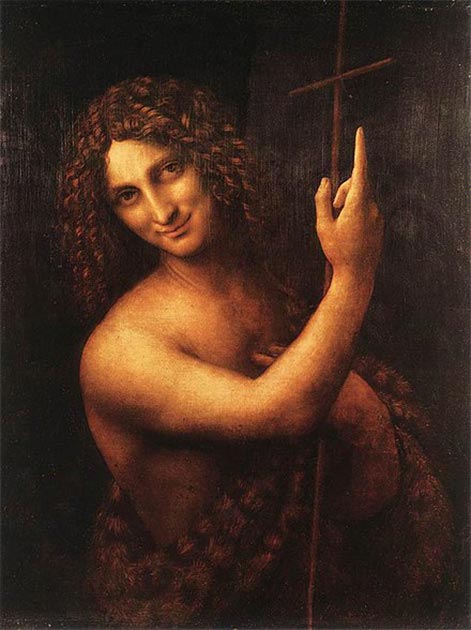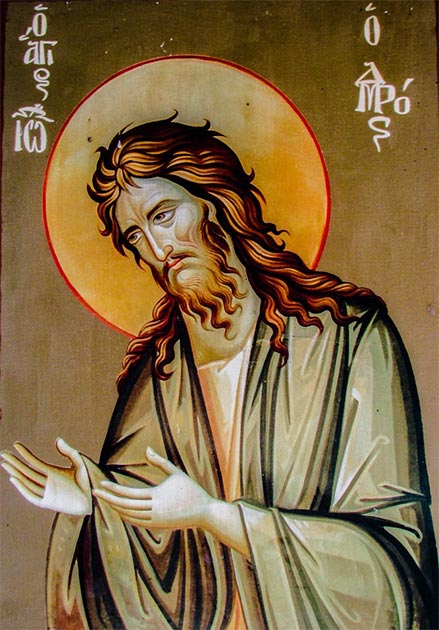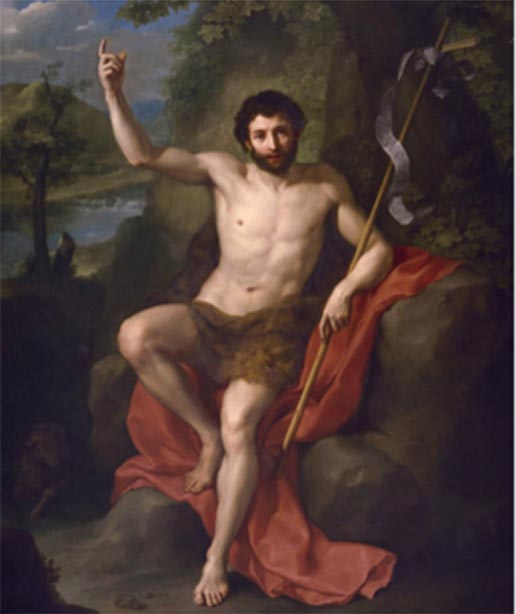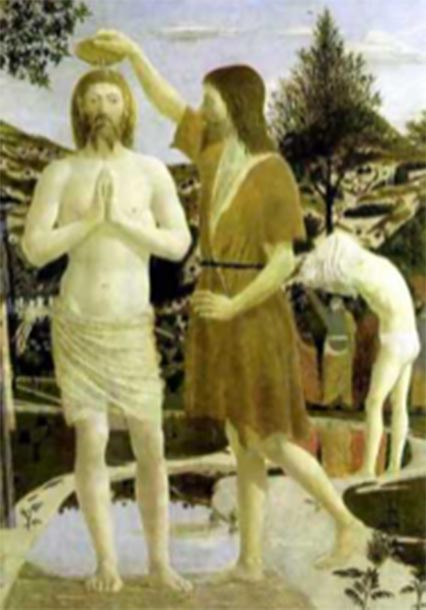
Jewish Prophet and Christian Saint – Who Was John the Baptist?
John the Baptist was a Jewish preacher and prophet who is believed to have been a forerunner to Jesus Christ. In the Book of Matthew in the Greek New Testament, John is depicted as another Elijah coming to announce the arrival of the Messiah. Jesus considered him to be the last and greatest of the prophets.
The Coming of the Messiah
The Jewish concept of the Messiah is first described by the Hebrew prophets, particularly the prophet Isaiah. In general, it was believed that the Messiah would be a descendant of David. It was also believed that he would restore Israel as a sovereign nation, gather the Jews who had been scattered across the earth, restore full observance of the Torah, and finally bring peace throughout the entire world.
Although there was disagreement on this point, many Jewish scholars believed that the peace brought by the Messiah would not only bring peace between humans but also peace within creation, as Isaiah prophecies: The wolf would dwell with the lamb... and they would both be led by a little child.
Part of the background of John the Baptist is an expectation of the coming of the Jewish Messiah. Another part of his background is the presence of ascetic communities living in the Judaean desert, who like John the Baptist lived a simple lifestyle and spoke of the need for preparation for a coming judgement.

Depiction of John the Baptist (Leonardo da Vinci (1513) / Public domain)
The Essenes and Their Monastic Way of Life
One such group was the Essenes. The Essenes were a Jewish sect that mostly lived in proto-monastic communities in the Judaean desert. Very little is known about them and much of what we do know is based on speculation.
The Essenes valued holiness and purity to such a degree that many of them felt the need to cut themselves off from the outside world. According to some sources, they believed that the material body was temporary and would fade away while the soul was eternal. Their beliefs regarding the resurrection of the body differed from other Jewish sects and it is suggested by some sources that they did not believe in the resurrection.
Some accounts reflect how bizarre the Essenes seemed to unfamiliar authors, especially Greco-Roman authors. According to one account, they considered the Sun to be sacred and their initiates would be given a spade-like instrument to dig a hole and cover their excrement from the rays of the Sun. One story also says that each morning before dawn they would pray for the Sun to rise or directly to the Sun, compelling it to rise.

‘Morning Prayers’ (circa 1936). The Essenes were thought to have had specific prayers related to the sunrise. (Otto Pliny / Public domain)
The Essenes believed that philosophy was useless, but they diligently studied ethics. They also are said to have studied minerals and materials with medicinal properties. Their interest in medicine was due to the importance of caring for the sick in their ethical system. The Essenes spent most of their time in agricultural pursuits or in artisanal activities. Essenes generally did not practice marriage and gained converts from outside the community.
Before joining an Essene community, an initiate had to spend a year observing their ascetic practices, before participating in Essene communal life. After this first year, the initiate would participate in the rites of the community except for the communal meals. It was only after these two years that they would be allowed to participate in the communal meals after taking oaths to honor God, to be loyal to the community and those in authority, and to observe justice among other obligations.
The daily routine of an Essene resembles modern monastic communities. They would wake up before dawn and pray before starting their daily work routine. At about 11:00 AM, they would have a communal meal where a priest would say grace. The rest of their day typically consisted of agricultural or artisanal work. In the evening, they would have another meal like the first meal of the day. Their mid-day meal had special significance as a sacred feast and strangers were not admitted. The Essenes valued living simple lives. They valued justice and were required to care for the sick regardless of creed.
Link to John the Baptist
John the Baptist resembles the Essenes in his asceticism and warning of a coming judgement. It has even been suggested that John the Baptist may have been trained or instructed by Essenes.
Unlike the Essenes, John the Baptist did not instruct his disciples to reject worldly goods or live an ascetic lifestyle. He simply required them to live an ethical life in whatever they did. The Essenes were also very strict in their observation of the Sabbath and other Jewish religious ordinances. John the Baptist does not appear to have emphasized these aspects of the Jewish law.

Depiction of Saint John the Baptist. (Public domain)
Despite these differences between John the Baptist and other Jewish hermits and ascetics in the desert, John would not have appeared out of place during this time as a Jewish ascetic and prophet, warning of future judgment and the coming of the Messiah. It is these similarities between John the Baptist and other Jewish religious teachers at the time, which demonstrates the connections between ancient Judaism and early Christianity.
Origin of John the Baptist: From the Womb to the Wilderness
The primary sources for the John the Baptist are the four gospels, Matthew, Mark, Luke, and John. The historian Flavius Josephus and traditions from the early Church also provide details, though they are sometimes considered to be of questionable reliability.
The father of John the Baptist was Zachariah, a priest of the order of Abijah. His wife was woman named Elizabeth. Zachariah’s wife was not able to have children, and they did not have any sons to carry on their lineage.
All the priestly orders had two turns a year to enter the temple and it was Zachariah’s turn to enter the temple as the people prayed outside. He did so and had a vision. An angel appeared to him and told him that his wife would bear a son who would be the forerunner to the Messiah. Zachariah, because of the age of himself and his wife, at first expressed skepticism. For this reason, the angel pronounced that he would be struck dumb, unable to speak, until the child was born.
As the angel said, Elizabeth became pregnant with a boy. During her pregnancy, she visited Mary, who had just become pregnant with Jesus. It is said that John the Baptist leapt in her womb when she was in the presence of Mary. This story is meant to show that, even while unborn, John the Baptist acknowledged the coming of the Messiah.

The Holy Children: John the Baptist (right) with child Jesus. (Bartolomé Esteban Murillo (1670) / Public domain)
Although there are traditions that tell of John the Baptist having to be hid away in the desert because of the wrath of Herod, in similar manner to Jesus, most of these tales are considered to be mere legends. What is known, is that at some point in his life John the Baptist did go out into the desert to the lower Jordan Valley, where he began preaching a message of repentance and a coming judgement.
The deserts of the lower Jordan Valley and Judea were known for being inhabited by Jewish hermits and groups such as the Essenes. John the Baptist would not have been out of character in this region. The Bible says that he wore camel’s hair and ate locusts and honey. One of the reasons he did this was to imitate the ancient Hebrew prophets who also lived in the wilderness for long periods of time. The prophet that John is most often associated with is Elijah.

John the Baptist preaching in the desert wilderness. (Anton Raphael Mengs (1760) / Public domain)
‘John the Baptizer’ and His Teachings
John soon gained a following of disciples of which he required baptism. It is perhaps more accurate to call John the Baptist ‘John the Baptizer’, since his teaching didn’t necessarily have to do with the Baptist movement in modern Christianity. John’s baptism also differed from the baptism required in later Christian sects.
Christian baptism is related to forgiveness and spiritual rebirth. The baptism of John was primarily related to repentance and preparation for a coming judgement. John also did not believe that his baptism was the ultimate. It was instead a preparation for a coming baptism that would be administered by a much greater being than himself.
John taught a basic moral message of living a life of justice and righteousness. In one instance, several Pharisees and Sadducees came to listen to one of John’s sermons and he condemns them as a “brood of vipers,” denouncing their hypocrisy.

John the Baptist preaching to the people. (Pieter Bruegel the Elder (1566) / Public domain)
He gave specific advice to others as well. He advised soldiers to not be abusive and to be content with their wages. He encouraged people living in abundance to give to those in need, “let one who has two tunics give to the one who has none.” Moral exhortations of this sort were common among Jewish rabbis and Hellenistic moralists.
Although John appears to have been uncertain at times as to whether Jesus was the Messiah, he does appear to have had a strong intimation of Jesus’ identity. When Jesus first came to be baptized, John refused, insisting that the role of baptizer and baptized should be the other way around. Jesus nonetheless insisted.
This episode suggests that John at least suspected that Jesus was important. Jesus’ role as the Messiah is further vindicated in the gospels by what occurs immediately after his baptism when a voice is heard from Heaven confirming that Jesus is the son of God the Father, or the Messiah in the Christian tradition.
Later, when John was in prison, there is a point where he sends some of his disciples to Jesus to ask him if he is really the one that they are looking for or if they should be looking for someone else. Many theologians believe, however, that this does not reflect doubt or uncertainty on John’s part but John trying to dispel doubts among his disciples by sending them to talk to Jesus.

The Baptism of Jesus Christ by John the Baptist. (Piero della Francesca (1449) / Public domain)
Imprisonment and Execution
John was not afraid to confront people of power about actions he considered to be immoral. Herod Antipas, ruler of Galilee and central Transjordan, at the time, was married to the daughter of Aretas IV, king of the Nabataeans. While visiting Rome, however, he fell in love with his niece Herodias who was the ex-wife of his brother Herod Philip. After divorcing his first wife, Herod Antipas married Herodias. John condemned this as unlawful according to Jewish moral teachings.
The Jewish people respected John as a spiritual leader and Herod probably feared that the prophet denouncing him might lead to a political backlash among the Jews. Regardless of the reason, he arrested John and placed him in prison. Although he had arrested John, John stilled had enormous respect among the Jewish people as a prophet and Herod was afraid to do anything to him, likely because he feared a revolt.
His lover, Herodias, on the other hand, apparently did not have such concerns. One day, her daughter danced before Herod. Herod was impressed and offered her daughter whatever she desired. The girl asked her mother Herodias, and Herodias told her to ask for the head of John the Baptist. The girl asked and Herod was forced to oblige.

The beheading of John the Baptist. (Pierre Puvis de Chavannes / Public domain)
- Secrets of the Knights Templar: The Knights of John the Baptist
- The Importance of Questioning History: From Malta to the Dead Sea Scrolls
- Reconstructing Jesus: Using Science to Flesh out the Face of Religion
Thus, the one whom Jesus called the greatest of the prophets was executed at the request of a dancing girl.

Herod, Herodias and their daughter (Salome) holding the head of Saint John the Baptist. (Tony Baggett / Adobe stock)
The Long-Held Legacy of John the Baptist
John the Baptist is widely revered within the Christian tradition and was one of the earliest saints to be given a feast day both in the western Roman Catholic and eastern Orthodox liturgical cycles. According to tradition, his bones were interned in Sebaste, or Samaria. They are said to have been kept there at least until about 362 AD. During the reign of Julian the Apostate, the shrine was apparently damaged, and the bones were partially burned. Some of the relics were rescued and carried to Jerusalem before being brought to Alexandria.
In 395 AD, his bones were allegedly placed in a basilica in Alexandria. Another part of John’s legacy is the myriad of churches, abbeys, and other religious structures that bear his name or patronage. The tomb at Sebaste also continued to be an important pilgrimage site after the shrine was damaged by Julian the Apostate and miracles are said to have occurred there because of the relics.
John the Baptist represents a link between ancient Judaism and early Christianity. He was a prophet and Jewish ascetic, similar to the prophet Elijah and also the Essenes, who wore camel’s hair and ate locusts and honey. He was also a forerunner to Jesus Christ who laid the foundation for the latter’s ministry in Palestine. In some ways, John was both the last of the Jewish prophets and the first of the Christian saints.
Top image: Mosaic of the baptism of Jesus Christ by Saint John the Baptist in Medjugorje, Bosnia and Herzegovina, 2016. Source: Adam Ján Figeľ / Adobe stock
By Caleb Strom
References
Editors of Britannica. 2008. Essene. Encyclopedia Britannica. Available at: https://www.britannica.com/topic/Essene
Editors of Britannica. Hellenistic Judaism. Encyclopedia Britannica. Available at: https://www.britannica.com/topic/Judaism/Hellenistic-Judaism-4th-century-bce-2nd-century-ce
Graham, Edward. 1909. Essenes. Encyclopedia Britannica. Available at: http://www.newadvent.org/cathen/05546a.htm
Kohler, Kaufmann. 1906. Essenes. Jewish Encyclopedia. Available at: http://www.jewishencyclopedia.com/articles/5867-essenes
Kohler, Kaufmann. 1906. John the Baptist. Jewish Encyclopedia. Available at: http://www.jewishencyclopedia.com/articles/8733-john-the-baptist
Silbermann, Lou Hackett, and Salo Wittmayor Baron et al. 2019. Judaism. Encyclopedia
Souvay, Charles. 1910. St. John the Baptist. Catholic Encyclopedia. Available at:
http://www.newadvent.org/cathen/08486b.htm
Strugnell, John. 2019. St. John the Baptist. Encyclopedia Britannica. Available at:
https://www.britannica.com/biography/Saint-John-the-Baptist
Telushkin, Joseph. 1991. Jewish Concepts: The Messiah. Jewish Virtual Library. Available at:
















Comments
More likely the JTB, like Jesus, was a fair-haired ancient Greek. The gospels are written in the ancient Greek language (not Hebrew). Herrod’s daughter would not have called for his ‘head’ on a platter were he Jewish. There is also a belief that JTB and the Greek god Pan were one and the same. The death of Pan was announcement right around that time, when both JTB and, some weeks later, Jesus, were killed.
Nobody gets paid to tell the truth.
Does that mean John the Baptist was an immaculate conception as well?
Hello Caleb,
This was mesmerizing to read I've been a Christian since I was a child or rather since before even knowing what the Word Christian meant, thanks for Posting this article it was quite insightful oh the Angel that addressed John the Baptist Father was the archangel Gabriel.
It was Gabriel who rolled away the stone from Jesus Tomb, and summoned Jesus from the Dead, and it was Gabriel; who addressed Jesus Follower's looking up at the sky where Christ had ascended "Ye Men of Galilee why do you continue looking up this same Jesus taken from you will return to you the same way.
Gabriel is also the one who helped Peter escape from Prison, before He was to be Put to death; and the one who executed King Herod's the Great-grandson for the murder of Jesus' Disciple James the older brother of John the Son's of Zebedee (He had James Beheaded similar to John the Baptist).
Did you know that Salome was actually nine years old? Herodias sent in her nine year old daughter to Dance for the King who Herodias made certain her husband would be very drunk for his birthday.
That's why Salome asked her mother what she should ask from the King? Mommy dearest then said The Head of John the Baptist. Since she was nine she most likely would have requested a elephant or a lion as a gift but the Bible says she couldn't think of anything she wanted.
Look forward to reading more of your articles. Thank you for sharing this one.
John the Baptist (born 6/1/6 BC julian d/m/y) is cousin Arjuna.
Elisabeth was two weeks late & His deadly wound was healed.
Jesus the Christ (born 6/6/6 BC julian d/m/y) is cousin Krishna.
Mary was two weeks early & John / Jesus born 5 months apart.
John signed G-D's work he copied w/his DOB.
Jesus signed G-D's work he copied w/his DOB.
They made 14 Rev. copies total.
They wrote what they saw, Rev.
Seven each, G-D
A lovely article.
................................................................................If it were true.